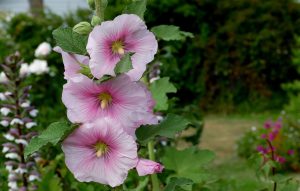Plants from the past that regain popularity are well worth growing in your garden. Hollyhocks (Alcea rosea) have existed since before recorded history. Alcea is a genus of about 60 species of flowering plants in the mallow family (Malvaceae). Originating in East Asia, hollyhocks were a gardening mainstay in ancient Japan. Their seeds and popularity traveled across Asia to the Middle East, where the English discovered them during the Crusades. Historical lore indicates that hollyhocks may have been named for the Holy Wars (holly) and the salve created to heal the Crusaders horses’ legs (hocks).
Hollyhocks were popular due to their reputation for growing almost anywhere in any climate and in any soil. During the 19th century Europe embraced gardening for reasons other than just food production. Every garden had a large stand of hollyhocks for not only their color but also for their medicinal value.
Before the advent of the corner drug store, plants were the option for home remedies. If you had a sunburn, shortness of breath, wounds, cramps, kidney or bladder problems, respiratory issues or convulsions, hollyhocks could be used as a poultice or in a tea. Hollyhocks have a high concentration of mucilaginous juice that is said to calm inflammation. In addition, according to the SPCA, https://www.aspca.org/pet-care/animal-poison-control/toxic-and-non-toxic-plants/hollyhock, hollyhocks are non-toxic to dogs, cats and horses.
Hollyhocks are the definition of an old-fashioned “pass-along plant.” It is a true cottage garden plant that supplies height and drama during the summer season and is happy anywhere but in soggy soil. They self-seed and will continue to grow wherever humans reside. The plants are biennials spending the first year growing their foliage and the second year providing a colorful, tall display of flowers. The plants make a great screen but often need to be staked due to their height (up to 8 feet). The colors are vibrant, ranging from white, deep red, pink, yellow, and maroon to almost-black.
In either spring or fall, pick a sunny location and work up the soil adding compost or planting mix. Make sure there is a wind break. Space the plants eighteen inches apart. Remember to remove any seed heads that grow to help continue the blooms. When the flowers have faded away, cut the stalk off at the base.
Hollyhock rust, Puccinia malvacearum, is a problem that can be controlled with better gardening practices. Rust creates noticeable yellow spots on the top of the leaves and reddish brown spots on the underneath. Spots grow together destroying large sections of foliage. The fungus likes hot and humid weather, so remember to water the soil and not the leaves. When you first notice rust, pick off the leaves and dispose of them in the garbage, not the compost pile. Create ample air circulation around the plants. Keep your garden weed free. Spread a layer of mulch over the ground to discourage last year’s spores. If need be, as a last resort, use a fungicide.
It is not every day that a piece of history may be planted in your garden. Hollyhocks remains have been found in an archeological dig buried with a Neanderthal man, they have marched in the crusades, acted like an all-night drug store, and provided inspiration for artists. How can you skip planting something as versatile as hollyhocks?
Julie Silva is a University of California Cooperative Extension Master Gardener of Tuolumne County who loves “old is new again” flowers.
UCCE Master Gardeners of Tuolumne County can answer home gardening questions. Call 209-533-5912 or go to: http://ucanr.edu/survey/survey.cfm?surveynumber=7269 to fill out our easy-to-use problem questionnaire. Check out our website at: http://cecentralsierra.ucanr.edu/Master_Gardeners/ You can also find us on Facebook, or pick up the local Master Gardener book “Sharing the Knowledge: Gardening in the Mother Lode” at Mountain Books or the UCCE Office both in Sonora, CA.


